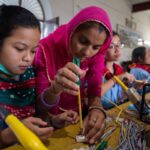

Introduction
Scientific advancements have reached a new high over the ages. Developments are visible in every field whether it be as complex as data science or something as simple as a glue gun which goes unnoticed by most of us. Similarly, advancements have been made by the science fraternity in the biological and reproductive field as well. Surrogacy is a method of assisted reproduction in which a woman carries and gives birth to a baby for another person who is are the intended social parents. Surrogate reproduction can either be through a gestational/IVF process wherein the baby has no genetic relation to the surrogate or through the traditional method with natural or artificial impregnation where the baby is genetically related to the surrogate and the male social parent. Surrogacy may be commercial or altruistic (without monetary compensation) in nature. Commercial surrogacy is legal in very few countries such as Ukraine and the Russian Federation.[1]
Childbirth is a beautiful process. It is a privilege that nature has particularly bestowed upon females, the capacity to procreate and expand their clan. However, there are many couples in the world who are deprived of this joy. One in every four couples in developing countries is found to be affected by infertility.[2] All over the globe, about 15% of the couples, of reproductive age, are affected by infertility. In India, primary infertility is estimated to range between 3.9 to 16.8%, because of which couples face extreme emotional and psychological trauma.[3] Thus, the urge for parenthood leads couples to take up alternate methods of having an offspring.
Research in the medical field has led to the development of artificial techniques of childbirth, assisting those who are unable to get pregnant. Artificial Reproductive Techniques (ART), In-Vitro Fertilisation (IVF), Intra-Uterine Injections (IUI), etc are all the other alternate techniques that have gained popularity in the lieu of this urge to have a child. The World saw its first IVF baby in the 1978 in London and the second was born in our own country, India, on 3rd October 1978, just two months after the first IVF birth.
India is a billion-dollar industry for surrogacy. Couples from various parts of the world, flock to India, to make surrogacy arrangements. Surrogacy in India, with respect to costs involved, is cheap and surrogates are easily available.
- MYTHOLOGY AND SURROGACY
Hindu Mythology
The Anushasana Pava, section 49 of the Mahabharat states the six type of sons that can be classified as kins and kinsmen-
“one’s own son; son born to one’s wife by an accomplished person; son born to one’s wife through another by payment; son of a remarried woman by her second husband or to a woman through niyoga (levirate) son born to the wife before her marriage; and son of an adulterous wife.”
Surrogacy as a practice can be traced back to the ancient times. The instances of the same can be seen in the epic of Mahabharat. Dhritarashtra’s wife Gandhari, was pregnant for more than a year, after which she gave birth to a mass of cells. Bhagwan Vyas found that there were 101 cells that were normal in the mass. These cells were then grown to full term, in vitro, out of which children were born (Kauravs). Not only do ancient Indian texts talk about birth through IVF but there are also examples of birth without a female.[4]
Sage Gautam, from his own semen, produced two children- a son Krip and a daughter Kripi, who were both test-tube babies and Sage Bharadwaj gave birth to Drona (Dronacharya). The story of birth of Drishtadyumn and Draupadi is even more interesting and reflects the supernatural powers of the great rishis. King Draupad’s enmity with Dronacharya resulted in a desired to have a son, strong enough to kill Drona. It is believed, Drupad was suggested Artificial Insemination Homologous (AIH) by a rishi, who even collected his semen for the same, however his wife refused to undergo the procedure. The rishi then put the semen in a Yajna-Kunda from which Dhrishtadyumn and Draupadi were born.[5]
- Christian Mythology
There were traces of surrogacy in Biblical times too. The Old Testament contains example of surrogacy. Abraham’s wife, Sarah, was infertile and so she commissioned her maid Hagar to bear her child with Abraham. Another example is that of Rachel, she was the wife of Jacob, who had no child for reasons of infertility. She commissioned her maid Bilhah to bear her a child with Jacob.[6]
- Islamic Mythology
In Islamic culture the concept of surrogacy is completely rejected. According to Islam and various Muslim Scholars, “Maqasid al- Sharī‘ah” or purposes of the Law lie with Protection of Religion, Life, Progeny, Mind and Wealth. The paramount necessities of human beings of protection, preservation and promotion are clearly being defined in this classification.
Since, Maqasid al- Sharī‘ah includes protection of progeny, treatment of infertility is preferred over surrogacy. Protection of progeny entails care for pregnant women and the health of the children and also preserves lineage. It is always preferred that a newborn be related to both his/her mother and father. The concept of womb renting has gained popularity in the world; however, the Islamic culture and bioethics have not yet welcomed this practice. Surrogacy procedures require a donor sperm. This sperm, which is a foreign element, is then put in the uterus of a woman, resulting in the mixing of lineage. This procedure is considered as equivalent to disregarding Allah.[7]
- SURROGACY IN INDIA : MEANING AND TYPES
The word ‘surrogate’ was derived from the Latin word ‘Surrogatus’ which means substitute, a person who acts on behalf on another. It is regarded as one of the best methods to overcome both biological and social infertility. It helps in providing an opportunity to the intending couple to have genetically related child through artificial reproduction and in vitro fertilization. The concept of surrogacy is widely recognized throughout the world. It is considered as a boon for infertile couples as it gives them the hope of having a child.
Blacks’ Law Dictionary defines Surrogacy as ‘an agreement wherein a woman agrees to be artificially inseminated with the semen of another woman’s husband.[8]
There are basically two types of surrogacy which are practiced in India:
- Traditional/Natural/Partial surrogacy:
In this the surrogate mother donates her egg well as acts as the carrier for the embryo. Commissioning father donates his sperm to become the genetic father of the child. Generally, the surrogate is impregnated using a process known as Intra-Uterine Insemination (IUI) or In Vitro Fertilization (IVF).
- Gestational surrogacy:[9]
In this the surrogate is not related to the child biologically at all. Her eggs are not used, and the embryo is actually created through a process called In-Vitro Fertilization (IVF). In this process, the biological father’s sperm and the biological mother’s egg is used to create an embryo. The surrogate only acts as a carrier of this embryo.
Like in other countries, in India also, the following two types of surrogacy arrangements are being practiced:
- Altruistic surrogacy: In this form of surrogacy, apart from necessary medical expenses, no financial rewards are given to the surrogate mother for her pregnancy or for relinquishment of the child to the genetic parents.
- Commercial surrogacy: In this form of surrogacy the surrogate mother does get financial rewards for carrying the child along with the necessary medical expenses she incurs.
India is a surrogacy heaven. Couples from across the globe flock the country to arrange for a surrogate and fulfil their desire of a child. The primary reason for people coming is the easy availability of surrogates and cheap facilities. Anand, Surat, Bhopal and Indore are bustling centers for surrogacy where several American, Russian and British women come to fulfil their desire for a child.[10]
The reasons for this booming medical tourism are varied. Some couples come here as the treatment is extremely expensive in their own country or for some, it’s the laws of their country that do not allow for surrogacy. A report stated that an account of a 37year old Russian who came to Bhopal for surrogacy arrangement as the expense for surrogacy is prohibitive in her country, ranging between Rs. 15,00,000 to Rs. 20,00,000, as compared to Rs. 2,00,000 cost in Bhopal. Also, the lack of easy availability of surrogates provokes couples to come to India.
Currently, India is the only country where surrogacy is neither banned nor regulated.[11] There exists no strict law that can effectively control the use and misuse of this practice of surrogacy in India. There is no check over any kind of exploitation of surrogates. Even the courts have not comprehensively addressed the subject.
- INDIAN JUDICIAL PRONOUNCEMENTS ON SURROGACY:
Baby Manji v. Union of India[12]
It was in 2009 that the first case of surrogacy surfaced on the floor of the Supreme Court. It is considered as a landmark case on surrogacy where the custody and motherhood of the baby was a question before the court.
A Japanese couple came to India and entered into a contract of surrogacy pursuant to which Baby Manji was born. Mr. Yamada was the commissioning father. The Japanese Civil Code does not recognize surrogate children and so Mr. Yamada was refused by the Embassy, a passport or visa in the name of baby Manji.[13] He then filed for an Indian passport for the baby, but the baby could not be issued one as the Indian passport requires a birth certificate for its issuance. The birth certificate issuance procedure in India requires the name of both the parents in it. The baby was born via surrogate and practically had three mothers- commissioning mother, anonymous egg donor and the surrogate. The authorities hence declined a birth certificate and consequently an Indian passport to Baby Manji. The baby’s grandmother fought the case for baby Manji. The court however, in this case, did not give any judgement but looped in the National Commission for Child Rights for further directions.
Jan Balaz v. Anand Municipality[14]
Famously known as the German Couple case, a childless German couple had come to India and commissioned a surrogacy contract through which twins were born to them with the help of a surrogate mother and the Anand Infertility Clinic, Gujrat.
Surrogacy as a means of parenthood is not recognized in Germany, following which surrogate born children are not recognized as German citizens. This law posed a significant barrier to the parents and to avoid any legal battle for immigration, the couple requested the Gujrat High Court to permit the surrogate children to carry Indian Passport.
Yet again the question of natural mother came up. Since there were no laws regulating the practice of surrogacy, the courts were inclined to believe that the gestational surrogate was the natural mother who has even donated the egg. The court with respect to the intending mother, held that the intending mother has neither donated the ova nor conceived or delivered the babies and is just the wife of the biological father. The court further held that, in the absence of any legislation, she can never be treated as a natural or legal mother.
Apart from these cases, two more cases came up in Mumbai, one in 2008 and the other in 2010, where two gay couples from Israel commissioned for surrogacy and after much legal struggle were able to take their surrogate children home, to Israel.
Therefore, the Indian courts, time and again, have been faced with this challenge of dealing with questions of citizenship, motherhood and immigration of the surrogate children. No concrete decisive steps have ever been taken by the judiciary in this regard. The Indian judiciary has not yet comprehensively addressed surrogacy, leaving the task to the legislature.[15]
Legislative Perspective:
India is the only country where surrogacy is neither banned nor regulated. No steps have ever been taken by the legislature to regulate the practice or direct the procedure. The result of the same is the creation of an open market for surrogacy where couples both, domestic and foreign, come frequently for commissioning surrogacy. This has led to increased medical tourism and a fair chance of surrogate exploitation.
Keeping in view the recent emerging problems with regard to surrogacy the Indian Council for Medical Research (ICMR) along with the Ministry of Health and Family Welfare, after many years of deliberations, formulated the National Guidelines for Accreditation and, Supervision and Regulation of ART Clinics in India in 2005. These regulations provide an easy guide to regulation of IVF and related technologies and also highlight the guidelines to regulate the practice of surrogacy. The major points that deal with surrogacy include[16]
A single contract will deal with the surrogacy arrangement between the parties. A proper financial support should be provided, to the surrogate child, in situations of death of either one or both of the commissioning parents, divorce before taking the delivery or failure to take the child after birth. No surrogate should be allowed to undergo more than five pregnancies including her own children. A maximum of 3 embryos are allowed to be implanted. A life insurance cover must necessarily be provided in the contract, for the surrogate mother. Right to privacy of the donor as well as the surrogate mother should be protected. Sex-selective surrogacy should be prohibited.[17]
- The Surrogacy (Regulation) Bill, 2016
It was only in 2016 that the government realized the need for making a specific legislation for surrogacy. The legislation aimed at banning commercial surrogacy. There was an evident increase in the reported cases of unethical practices, ill-treatment of surrogate mothers, desertion of children born out of surrogacy and import of human embryos and gametes.[18] The Law Commission too in its 228th Report, suggested banning the practice of commercial surrogacy by passing a suitable legislation.
An in-depth analysis of the bill shows that the bill proposes to allow altruistic ethical surrogacy. Any infertile Indian married couple between the age of 23-50 years and 26-55 years for female and male are eligible to get into the process of surrogacy. However, the bill requires any such intending couple to be married for 5 years before getting into any such contract and there should not be any surviving biological, adopted or surrogate child. The only exception is when the child they have is mentally or physically challenged or suffers from a threatening or permanent disorder with no permanent cure.[19]
The bill favors and promotes ethical altruistic surrogacy and so requires the surrogate mother to be a close relative of the intending couple between the ages of 25-35. The clinics acting as intermediaries for such surrogacy contracts are supposed to maintain a record for about 25 years of every surrogate mother and child so born. The termination of such a pregnancy can only be commissioned by prior permission of the surrogate mother and on authorization of the appropriate authority. The bill talks about setting up of a National Surrogacy Board and State Surrogacy Boards. These boards are supposed to be the policy making bodies for the practice of surrogacy and there should be Appropriate Authority for the implementation body for the Act. The total number of members in these boards should be 24. The bill clearly specifies the members and process of creation of these boards. [20]
- The Surrogacy (Regulation) Bill, 2019
The 2016 Surrogacy bill lapsed as the session of Parliament adjourned for the term. The same bill again, with no changes at all was tabled in 2019 on the floor of the Parliament. This reintroduced bill was promptly passed by the Lok Sabha and so was sent to the Rajya Sabha. Although the Bill ignores suggestions of ICMR and a Parliamentary panel to first regulate assisted reproductive technology (ART) clinics and retains restrictive definitions and unwarranted regulatory provisions raising serious doubts about its efficacy to achieve its objective.[21]
The Surrogacy (Regulation) Bill 2019 was introduced in the Lok Sabha with to facilitate altruistic surrogacy in the country. The government claims that regulating surrogacy will put an end to rampant commercialisation of the practice. The commercialization of surrogacy has left a lot of women from underprivileged backgrounds, who lend their wombs, in a vulnerable condition. Although some of the features of the Bill 2019 are that it provides for constitution of surrogacy boards at the national as well as state levels to ensure effective regulation.[22]
It seeks to allow ethical altruistic surrogacy to the intending infertile Indian married couple between the age of 23-50 years for female and 26-55 years for male. Only Indian couples who have been legally married for at least 5 years would be allowed to opt for surrogacy. It makes it mandatory for the couple to obtain a certificate of essentiality and also a certificate of eligibility before going ahead with surrogacy. It also provides that intending couples should not abandon the child born out of surrogacy under any condition. Further the Bill also seeks to regulate functioning of surrogacy clinics.[23] All surrogacy clinics in the country need to be registered by the appropriate authority in order to undertake surrogacy or its related procedures.
Issues Related to Surrogacy (Regulation) Bill 2019:
Currently, Surrogacy in India is legitimate because no Indian law prohibits surrogacy. However, Surrogacy (Regulation) Bill 2019 seeks to prohibit commercial surrogacy and provide only for Altruistic surrogacy. Altruistic surrogacy includes contracting a ‘close relative’ as a surrogate by a heterosexual married couple who have been childless for five years of their marriage. However, the Bill lacks the definition of the ‘close relative’. Further the Bill specifies that the intending couples should be married Indian couples.[24] There is no mention of Non-Resident Indians working or studying abroad who may want to come back home to have a baby. The Bill further clarifies that any form of monetary compensation or advertising about the act of surrogacy is a punishable criminal offence. But due to this, the livelihood of poor women who are engaged in commercial surrogacy will get compromised.
Way Forward
For surrogacy to happen, we need embryos, and embryos are cultured in various In-Vitro Fertilization (IVF) laboratories. So, regulation of surrogacy must be preceded by law on Assisted Reproductive Technology (ART). Rather than penalizing surrogacy, the person providing a womb for surrogacy must be secured with a contract, ensuring proper, insurance and medical checks. Right to privacy of donor as well as surrogate mother should be protected. Surrogacy should be made inclusive for all class of people irrespective of their sexuality.[25]
The Surrogacy (Regulation) Bill 2019 cements the ban on commercial surrogacy, but it fails to effectively tackle the larger social, physical, psychological, emotional and economic issues that continue to challenge the welfare and safety of both the surrogate mother and the child.
Conclusion
Surrogacy, a million-dollar industry, is booming in India. It is giving hopes to a lot of parents who because of some inability or other are not able to conceive. Parenthood is a joy that every couple seeks after some time. It completes the family and brigs joy. Surrogacy is now coming up as an easy alternative to all those parents who want their child to be related to them by genes and blood. It is upcoming and is gaining popularity among the newer generations as the infertility rates too are going up with years. Looking at the current scenario in India it is very much the need of the hour to regulate this market of surrogacy and to fill in the lacunae so that no scope for exploitation is there of the surrogate mother and to provide with utmost security to the so born surrogate child.
Banning commercial surrogacy is no solution to the problem this industry faces. Banning commercial surrogacy will lead to many more problems such as black market, greater exploitation and sociological and psychological impacts on the surrogates considering only altruistic surrogacy is being done. The government must alter the bill to make it more inclusive and comprehensive. Proper guidelines must be laid out so that surrogacy becomes an easy recourse to all those who are unable to fulfil their desire of a child. Creation and implementation of stricter regulations is necessary and a dire need of the hour.
About the Authors
Abhishek Mishra recently completed his LLM in Constitutional Law from Amity University Uttar Pradesh. He also qualified UGC-NET. His interest lies in Constitution and contemporary social issues.
Vandana completed B.A-LL.B. from JV University, Jaipur in 2017. Thereafter she did pursue LLM from Amity University Lucknow, UP in 2019.
She is presently working as a Guest Faculty at Patna Law College, Patna University. Her research interest includes corporate law and constitutional law.
References
-
Available at https://www.drishtiias.com/daily-updates/daily-news-editorials/surrogacy-regulation-bill-2019 ↑
-
Demographic and Health Surveys, in collaboration with WHO,2004. ↑
-
Available at https://www.nhp.gov.in/disease/reproductive-system/infertility. ↑
-
Dr. Ralla Guha Niyogi, May You Be the Mother of a Hundred Sons: Social and Ethical Impact of Surrogacy in Ancient Indian Myth, 1 BHARATIYA PRAGNA: AN INTERDISCIPLINARY JOURNAL OF INDIAN STUDIES, 20, 24 (2016). ↑
-
Surrogate Motherhood: History and Concept. ↑
-
The Holy Bible, Genesis 30:1-8. ↑
-
Sharmin Islam et al. Ethics of Surrogacy: A Comparative Study of Western Secular and Islamic Bioethics 44 JOURNAL OF ISLAMIC MEDICAL ASSOCIATION OF NORTH AMERICA (2013) ↑
-
Oliphant RE. New York: Aspen Publishers; 2007. Surrogacy in Black law dictionary, family law; p. 349. ↑
-
S.S Das & Priyanka Maut Das, Commercialization of Surrogacy in India: A Critical Analysis, V JCC Law Review 14 (2014). ↑
-
https://www.drishtiias.com/daily-updates/daily-news-editorials/surrogacy-regulation-bill-2019 ↑
-
Baby Manji Yamada v. Union of India and Another AIR 2009 SC 84 (2008) ↑
-
Baby Manji Yamada v. Union of India and Another AIR 2009 SC 84 (2008) ↑
-
Ibid. ↑
-
Jan Balaz v. Union of India AIR 2010 Gujarat 21. ↑
-
Jasdeep Kaur, Surrogacy: A Paradox Regarding Motherhood Rights with Special reference to India, 2 THE LEGAL ANALYST, 113,119 (2012) ↑
-
National Guidelines for Accreditation, Supervision and Regulation of ART Clinics in India, Indian Council of Medical Research (ICMR), 2005, Ministry of Health and Family Welfare, Government of India, New Delhi. ↑
-
National Guidelines for Accreditation, Supervision and Regulation of ART Clinics in India, Indian Council of Medical Research (ICMR), 2005, Ministry of Health and Family Welfare, Government of India, New Delhi. ↑
-
The Surrogacy (Regulation) Bill, 2016. ↑
-
The Statement of objects and Reasons, The Surrogacy (Regulation) Bill, 2016 ↑
-
Ibid. ↑
-
Available at https://www.businesstoday.in/current/policy/surrogacy-regulation-bill-2019-infertility-indian-council-of-medical-research-icmr-surrogate-mothers-in-vitro-fertilisation-ivf/story/372797.html. ↑
-
Available at https://www.drishtiias.com/daily-updates/daily-news-editorials/surrogacy-regulation-bill-2019 ↑
-
Ibid. ↑
-
Available at https://www.businesstoday.in/current/policy/surrogacy-regulation-bill-2019-infertility-indian-council-of-medical-research-icmr-surrogate-mothers-in-vitro-fertilisation-ivf/story/372797.html. ↑
-
Ibid. ↑n





Very good information. Lucky me I came across your blog by chance
(stumbleupon). I’ve bookmarked it for later!
Hey there! Someone in my Myspace group shared this site
with us so I came to take a look. I’m definitely enjoying the information. I’m book-marking and will be tweeting this to my followers!
Excellent blog and excellent design.
My husband and i were very comfortable when Ervin managed to conclude his investigation via the ideas he received through your site. It’s not at all simplistic to just happen to be making a gift of methods which often many others have been making money from. Therefore we take into account we’ve got the blog owner to be grateful to for that. All the illustrations you have made, the straightforward web site menu, the friendships you will give support to create – it’s got everything fantastic, and it’s assisting our son in addition to our family do think the situation is awesome, which is seriously indispensable. Many thanks for all the pieces!